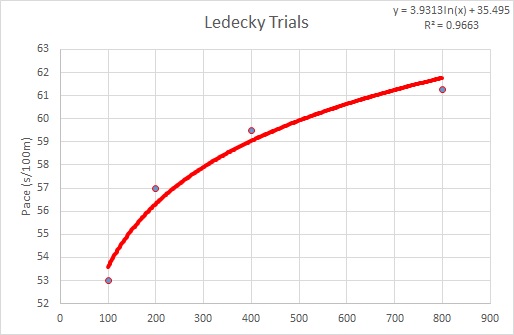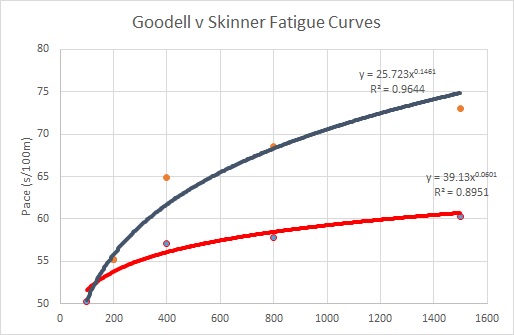Swim benchmarks for developing triathletes.
Alan Couzens, M.S. (Sports Science)
July 27th, 2016

Olympic years are my favorite. The energy, the inspirational stories, the build up. A few weeks back, we had a good dose of all of the above at the U.S. Olympic swim trials & a lot of it centered around a young swimmer by the name of Katie Ledecky.
Katie has exhibited a dominance in distance swimming that has not been seen to this point. At the trials, this dominance grew, as she extended her range of being truly competitive all the way down to the 100 meter events. This is akin to Paul Tergat going head to head with Michael Johnson in a 400 around the track. Unheard of!
Katie’s meet schedule reminded me of my days as a young, developing, age group swimmer where we rocked up to a swim meet ready to swim every event on offer. Only she was doing the same thing at a truly elite level!
For us swimming stats geeks, a neat side effect of Katie’s willingness to front up for practically every event on the card is that we get a glimpse into the pace-duration curve of a world class distance swimmer. This is shown in the chart below.

As you can see, Katie’s pace per 100 drops off by a fairly steady 4% as the distance doubles. I’m not the first to look at these ‘critical pace curves’ for swimmers. One of my true idols, & a pioneer in the combo sports scientist-coach domain, Aussie swim coach, Forbes Carlile investigated this relationship for a number of world class swimmers way back in 1979. He found a similar pattern for the distance swimmers, i.e. a curve of ~4% as shown by world record holder at the time in the 400 & 1500m, Brian Goodell.
However, he found that elite sprint swimmers showed a different curve, something in the 10% drop off region, i.e. velocity fell by ~10% as the distance doubled (as shown by sprint specialist & former 100m world record holder, Jonty Skinner)

These 2 lines can be considered extremes of specialized preparation. Despite Katie’s ability to compete at all distances, she is clearly trained to be stronger at one end of the spectrum (& she’s just so good at that end that even with a distance swimmers curve, she happens to still be very competitive at the shorter events!)
When looking at these curves, it is important to remember that these 'borders' of specialization are the domain of the master. In high performance swim programs, division of the group into distance v sprint squads happens after the swimmer is already very fast across the board! If you're a 60 minute Ironman swimmer, you're not a 'distance swimmer', you're a developing swimmer!
Side rant: Early specialization is, in my opinion, one of the greatest problems in sport, leading to early plateaus and burnout, yet it is rife in the "Ironman obsessed" world of triathlon, where athletes get the 'Ironman bug' before a good strength/speed/technique foundation is established. Particularly in the pool, we need to take a step away from that.
For a developing swimmer, I would always aim for something in the middle of that curve until their natural strengths become apparent. If you’re not swimming 80K per week, a 4% curve may be more indicative of a speed/skill weakness than an aerobic strength! I talked a little about that here. For developing athletes (i.e. athletes not swimming at an elite level within their sport), a curve smack bang in the middle of those 2 extremes, i.e. ~7% should, in my opinion, be the initial goal – become a good all around swimmer first and then a great sprint/distance swimmer.
(Of course, :-) I’ve prepared a calculator around this 7% line below…
Ironman split (mins) Fatigue curve: Distance Sprint (7%)
| Distance | Time |
|---|---|
| 3800m | |
| 1900m | |
| 1500m | |
| 800m | |
| 400m | |
| 200m | |
| 100m | |
| 50m |
You can plug in your target Ironman time and it will offer shorter benchmarks that fall on this 7% curve. If you are already a good swimmer (~55min IM), you may want to nudge it up a click towards the distance specialization. If you're already a really good swimmer, swimming at an elite level (at or below 50min), you might want to nudge it up 2 clicks. If you're ready to give Ledecky a run for her money, feel free to take it all the way left to her 4% curve. :-)
You'll see at a certain point how specialization *has* to come into play. If you put in a 45min IM split on a 7% curve, you'd be basically swimming at a world class level for every distance along the spectrum! At this point, training for a highly specialized physiology is, obviously, essential. But, before that point, having the ability to hit strong paces across the board is a desirable aim & is more indicative of something else...
While the ‘fatigue curve’ is a great indicator of an athlete’s overall physiology on the bike or run, if we look at it in the pool, it is more likely to be an indicator of an athlete’s technical skill, especially for the developing athlete. Due to the exponential relationship between hydrodynamic drag & velocity, water punishes technical flaws more the faster you go. So, if the water is punishing you, it’s a good sign that there are some technical limiters related to drag that need polishing. This may be a poor body position, it may be an excessively wide or deep arm stroke or it may be a lack of continuity in the stroke that leads to stopping and starting. Whatever the ailment, an improvement in your basic speed (without a lot of specific anaerobic training to that end) is generally a positive sign.
If your basic speed is not where you want it, a block devoted to a mix of appropriate technical drills coupled with short, frequent 'check ins' on your basic speed can lead to significant improvement across all distances. Again, this isn't anaerobic training, it is speed practice. The emphasis is holding quality technique at or above race speed coupled with a lot of easy (but still technically perfect) aerobic work in between to recover. Lactate levels should be less than 2mmol/L for the bulk of work with a technical emphasis.
Bottom line: A fast swimmer is a fast swimmer (across all distances). Therefore, it's important to keep checking in on your benchmarks across the speed spectrum as your swim is developing, with particular attention to the high speed/high drag end on a regular basis. When it comes to swimming economy, the clock doesn’t lie.
Swim smart,
AC
TweetDon't miss a post! Sign up for my mailing list to get notified of all new content....
